K-drama Food:
What's That They're Eating? |
One of the things I like most about Korean dramas is how much attention is given to food. You can learn so much about a culture just through what they eat. I've actually been eating Korean food well before I started watching K-dramas. I have long-time Korean-American friends that have introduced me to a number of dishes over the years, and I've always enjoyed exploring cuisines of different cultures on my own. When I got into K-dramas, it was great to see things I had never heard of, that I wouldn't find in Korean restaurants here. Curiosity led to answers, me annoying my friends, and further exploration. If you've ever been curious about the foods you see, I've saved you the trouble by compiling a list of some common foods in K-dramas. Time to get the scoop on what that is they're eating. |
|
Jajangmyeon (black bean noodles) |  | 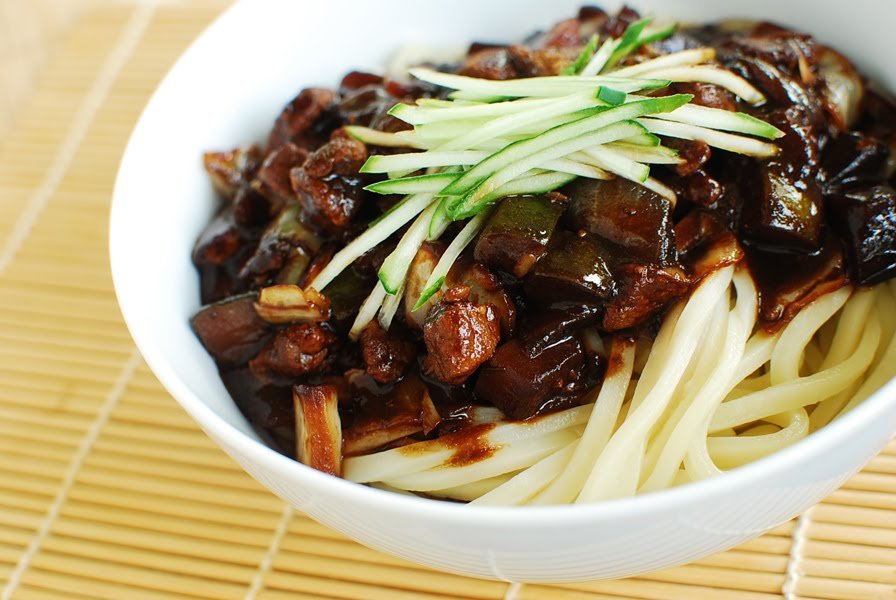 JaJangmyeon is the Korean spelling for this noodle dish that originates in the Shandong region of China. It's pronounced pretty much the same in Chinese ('J' has slight a 'ch' sound in Korean), but uses different characters. It's a dish of fried black bean sauce atop thick flour noodles which are usually handmade. It's widely popular in Korea due to its very low price and availability. It's viewed as inexpensive — yet very delicious — comfort food. JaJangmyeon is the Korean spelling for this noodle dish that originates in the Shandong region of China. It's pronounced pretty much the same in Chinese ('J' has slight a 'ch' sound in Korean), but uses different characters. It's a dish of fried black bean sauce atop thick flour noodles which are usually handmade. It's widely popular in Korea due to its very low price and availability. It's viewed as inexpensive — yet very delicious — comfort food.
I've only had the Chinese version here in the States, and it looks nothing like the images of the Korean version. I can tell you the type I've had isn't all that, either. No handmade noodles over here, ya'll. |
|
Samgyetang (ginseng chicken soup) | 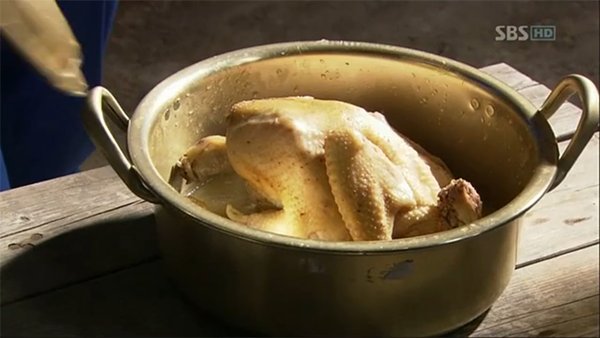 | 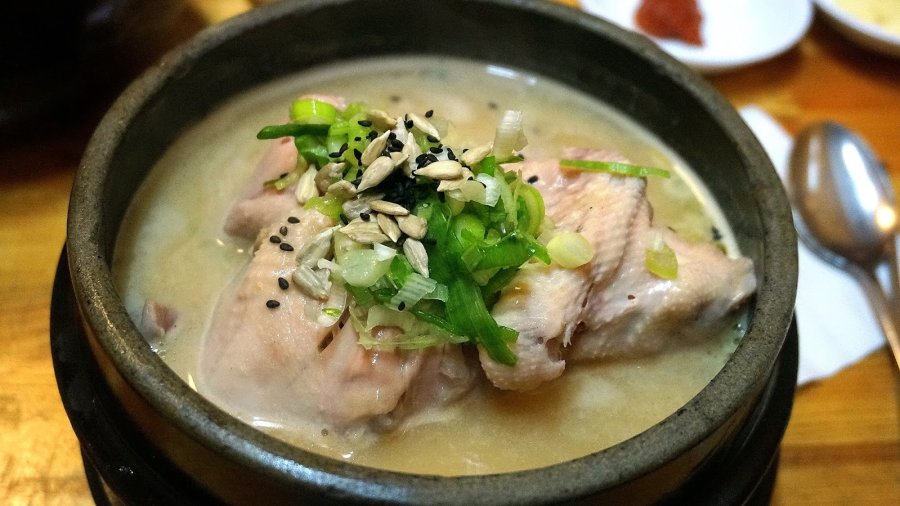 A summertime favorite, this soup consists of a young hen that is usually stuffed with sweet rice, then simmered in a broth that includes: ginseng, chili pepper paste, scallions, and jujube fruit. It's typically eaten on really hot summer days as it's believed to be a very healthy dish with revitalizing qualities. It is especially eaten on Sambok days to help beat the heat. A friend of mine in Seoul would go on and on about eating this chicken when it was really hot there. They craved it more than ice cold water. Hot chicken soup over ice water. A summertime favorite, this soup consists of a young hen that is usually stuffed with sweet rice, then simmered in a broth that includes: ginseng, chili pepper paste, scallions, and jujube fruit. It's typically eaten on really hot summer days as it's believed to be a very healthy dish with revitalizing qualities. It is especially eaten on Sambok days to help beat the heat. A friend of mine in Seoul would go on and on about eating this chicken when it was really hot there. They craved it more than ice cold water. Hot chicken soup over ice water.
|
|
Kimchi |  |  I'm sure pretty much everyone is familiar with kimchi. But you may not know that kimchi is a broad term used to refer to fermented vegetables. There are various types of kimchi. The most popular one (which is probably what you're most used to seeing) is baechu kimchi (napa cabbage). Other common varieties are: I'm sure pretty much everyone is familiar with kimchi. But you may not know that kimchi is a broad term used to refer to fermented vegetables. There are various types of kimchi. The most popular one (which is probably what you're most used to seeing) is baechu kimchi (napa cabbage). Other common varieties are:
If you go to eat at a Korean restaurant, you'll usually get at least 3 different types of kimchi with your meal as part of banchan (we'll get to that term later). While my all-time favorite is baechu kimchi, oisobagi kimchi comes in second. I'm pretty picky about my kimchi, too. I like a certain balance and blend of spices along with vegetable-to-liquid ratio. I used to think there was no way for me to consistently find my particular set of preferences until I learned that kimchi also varies by regions and seasons. It seems I'm a Gyeongsang-do/Autumn kimchi type of gal. |
|
Haejangguk (hangover soup) |  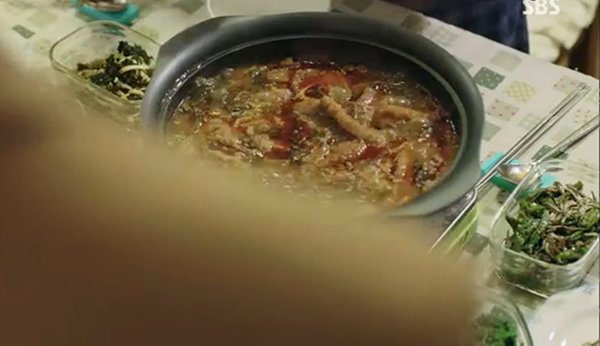 | 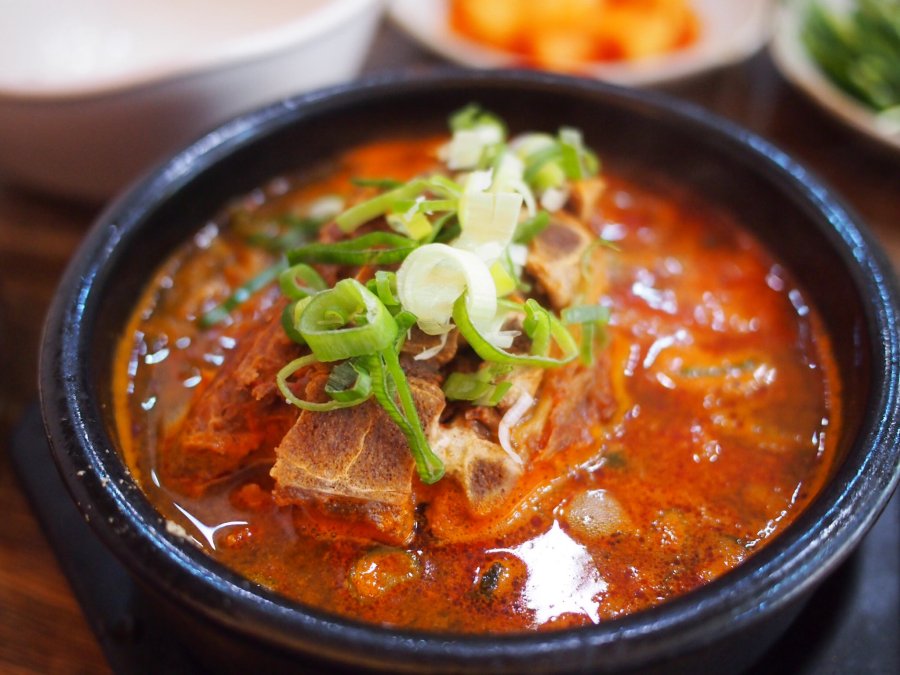 This actually is another broad term that refers to a variety of soups people in Korea tend to eat while trying to cure a hangover. Soups are usually a base mixture of beef broth, congealed ox blood, napa cabbage, scallions, and various other veggies. (In my English accent) I need some bloody soup! This actually is another broad term that refers to a variety of soups people in Korea tend to eat while trying to cure a hangover. Soups are usually a base mixture of beef broth, congealed ox blood, napa cabbage, scallions, and various other veggies. (In my English accent) I need some bloody soup!
Jeonju-style is to crack a raw egg over the finished soup. Nothing like bloody, raw egg, beefy soup for getting over nausea. I've always found it interesting that they eat soup whereas here in The States we shoot for greasy, solid food. I know for sure the sight of a raw egg would escalate things quickly in the wrong direction for me if I were hungover. I tip my hat to the iron stomachs of the world. |
|
Tteokbokki (spicy rice cakes) | 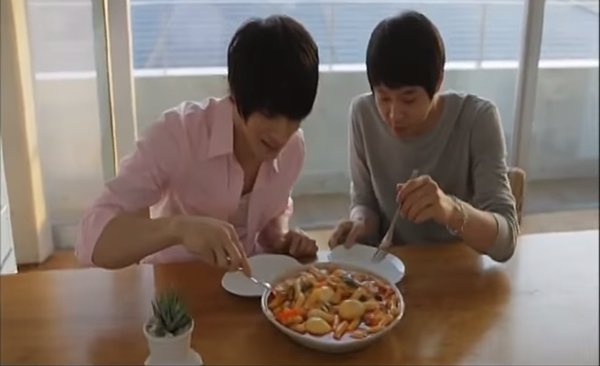 |  Tteokbokki is pretty straightforward. Tubular cakes of glutinous rice (similar to mochi) are simmered in a fairly spicy sauce that has a touch of sweetness. The commonly preferred preparation is for the cakes to be chewy with a little crisp to them. Personally, I like mine less chewy and the sauce not too spicy. But I'm in the minority, it seems. Tteokbokki is pretty straightforward. Tubular cakes of glutinous rice (similar to mochi) are simmered in a fairly spicy sauce that has a touch of sweetness. The commonly preferred preparation is for the cakes to be chewy with a little crisp to them. Personally, I like mine less chewy and the sauce not too spicy. But I'm in the minority, it seems.
This dish is viewed more as a snack than a meal in Korea. You'll find it at open air markets where prepared food is sold from street vendors and also at "mom-and-pop" type restaurants. However, it's pretty easy to make at home. Get a package of the rice cakes, whip up some sauce, work it all together, pop in some boiled eggs/green onions, and you're tteokbokki dope fresh! |
|
Samgyeopsal gui (grilled pork belly) |  | 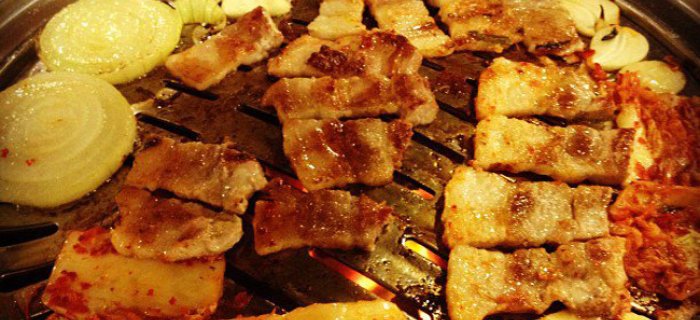 My unscientific (read: surmised) measurement of data says that this is the most common food in Korean dramas. I could be wrong, but who's gonna prove it? Huh? Who? Ah ha ha ha! Now, dance! My unscientific (read: surmised) measurement of data says that this is the most common food in Korean dramas. I could be wrong, but who's gonna prove it? Huh? Who? Ah ha ha ha! Now, dance!
Ahem, *cough* so Samgyeopsal gui s usually the opening for most drunk scenes in our beloved Korean dramas. Pieces of pork belly are placed on a grill situated in the middle of a table, cut while cooking, and consumed quickly. It is the super-hero of Korean BBQ as it's a low cost meat, but decently filling. The fat helps with drinking, not too hard to digest, and the smell doesn't stay long on your clothes. If you've ever been to a Korean BBQ place, you know well what I speak of in regard to lingering odors. Interesting to me, again, is how inexpensive pork belly is in Korea. It's so not cheap here, and often treated as a gourmet item. Whereas fruit in Korea is pricey, but I can get a pound of organic apples for like $3 here. Ah, aren't cultural differences fascinating? |
|
Banchan (side dishes) |  |  I mentioned this earlier when talking about Kimchi. As you've definitely seen many times when Koreans in dramas sit down to have a meal, there's usually a main dish and then many little plates of various foods on the table. Those various foods are called banchan, and they are considered components of a traditional Korean meal. There's no set number or set items. They can vary depending on what the main dish is going to be. In restaurants, though, there's a typical selection you'll receive. As I mentioned earlier, you'll usually find at least 3 types of kimchi among them. Some other foods you may get are: I mentioned this earlier when talking about Kimchi. As you've definitely seen many times when Koreans in dramas sit down to have a meal, there's usually a main dish and then many little plates of various foods on the table. Those various foods are called banchan, and they are considered components of a traditional Korean meal. There's no set number or set items. They can vary depending on what the main dish is going to be. In restaurants, though, there's a typical selection you'll receive. As I mentioned earlier, you'll usually find at least 3 types of kimchi among them. Some other foods you may get are:
- Sigeumchi namul (spinach in sauce)
- Gaji namul (boiled eggplant)
- Buseot bokkeum (stir-fried mushrooms)
- Dubu-jorim (tofu in sauce)
- pajeon (pancake w/green onions)
- Japchae (glass noodles w/veggies + sauce)
Some places may also have Korean-style potato salad (which I love) that is made with apples and carrots. A Korean family owns a Japanese restaurant I used to frequent (yes, Japanese) where they have Korean dishes on the menu, as well. That's pretty common here. Anyways, the mom used to include her Korean-style potato salad with the galbi (short ribs) plate, but not many people would eat or even taste it. So, she stopped making it altogether and replaced it with some iceberg lettuce buffet-type of salad. Booooo! Non-adventurous eaters ruined it for all. It was a really good potato salad. |
|
Gimbap (korean maki roll) |  |  Do you know sushi (specifically, maki rolls)? Do you know bibimbap? Well, put 'em together and you have gimbap. It's like bibimbap rolled up in nori. You might say, isn't that just Korean sushi? Not really. Sushi refers to ingredients combined with soured rice; the word itself literally translates to "sour-tasting." One key characteristic of sushi is the vinegar the rice is tossed with immediately after it is ready. Gimbap started as a remnant of futomaki from Japanese occupation in Korea. However, gimbap changed from futomaki when sesame oil was used instead of vinegar for the rice. If you're not familiar with these ingredients, let me tell you that makes a big difference in taste. So, it's more like Koreans kept the futomaki, but made it their own. Do you know sushi (specifically, maki rolls)? Do you know bibimbap? Well, put 'em together and you have gimbap. It's like bibimbap rolled up in nori. You might say, isn't that just Korean sushi? Not really. Sushi refers to ingredients combined with soured rice; the word itself literally translates to "sour-tasting." One key characteristic of sushi is the vinegar the rice is tossed with immediately after it is ready. Gimbap started as a remnant of futomaki from Japanese occupation in Korea. However, gimbap changed from futomaki when sesame oil was used instead of vinegar for the rice. If you're not familiar with these ingredients, let me tell you that makes a big difference in taste. So, it's more like Koreans kept the futomaki, but made it their own.
|
|
Chimaek (chicken and beer) | 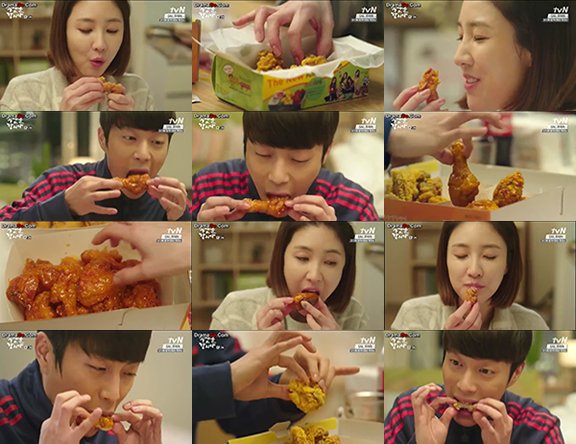 | 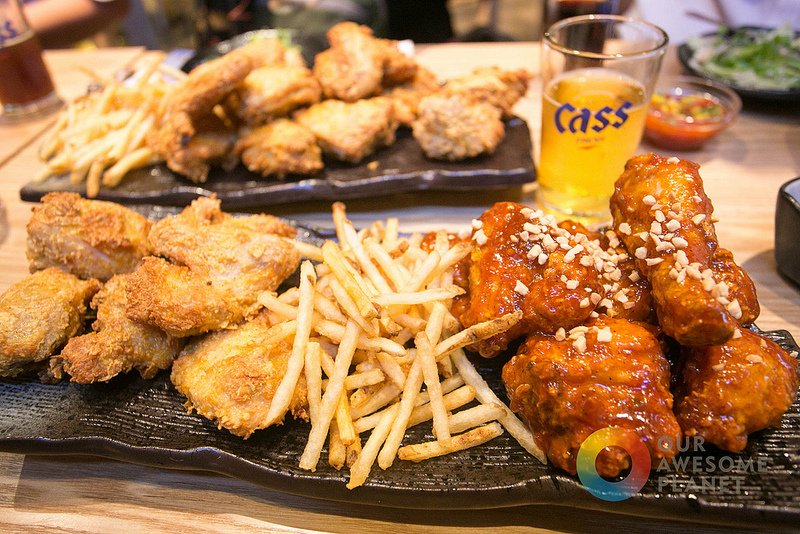 While watching some dramas, I used to wonder why characters would go nuts over having fried chicken and beer. Mainly the fried chicken, but beer seemed to be the optimal drink for accompaniment. When I visited Korea, I wondered no more. Hands down, Korea has the best fried chicken ever. Ever! I dream of that chicken often. I miss it dearly. I tell you no lies. While watching some dramas, I used to wonder why characters would go nuts over having fried chicken and beer. Mainly the fried chicken, but beer seemed to be the optimal drink for accompaniment. When I visited Korea, I wondered no more. Hands down, Korea has the best fried chicken ever. Ever! I dream of that chicken often. I miss it dearly. I tell you no lies.
Fried chicken is a thing in The States. Crispiness, breading, seasoning… to get it all right is an art form. The South is well known for being royalty when it comes to fried chicken, and I thought that was the best there could ever be. Oh, how wrong was I. I don't know what kind of magic Koreans wield when it comes to that crunchy fried goodness, but they wield it well. The most magical part of all? It's not even greasy! How in the world?!?! Chicken shops are o'plenty in Seoul, so you don't have to look far to feed your need. You can get the typical pieces; legs, breasts, thighs, and wings. The fun part comes in with the sauces you can choose from. Lots of places let you split boxes so you're not committed to just one flavor for your whole batch. And if you're trying to do the whole package, but don't want to go out, many places will deliver beer, too. Chimaek me, bro! |
|
Yakult (yogurt drink) | 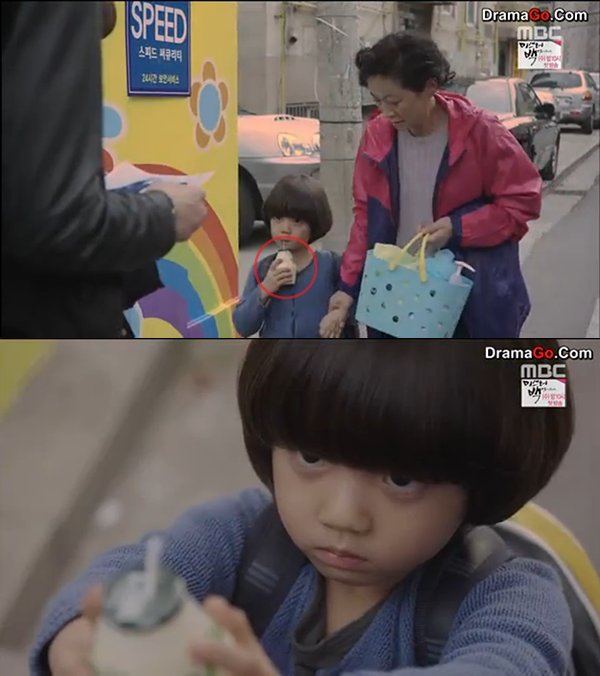 | 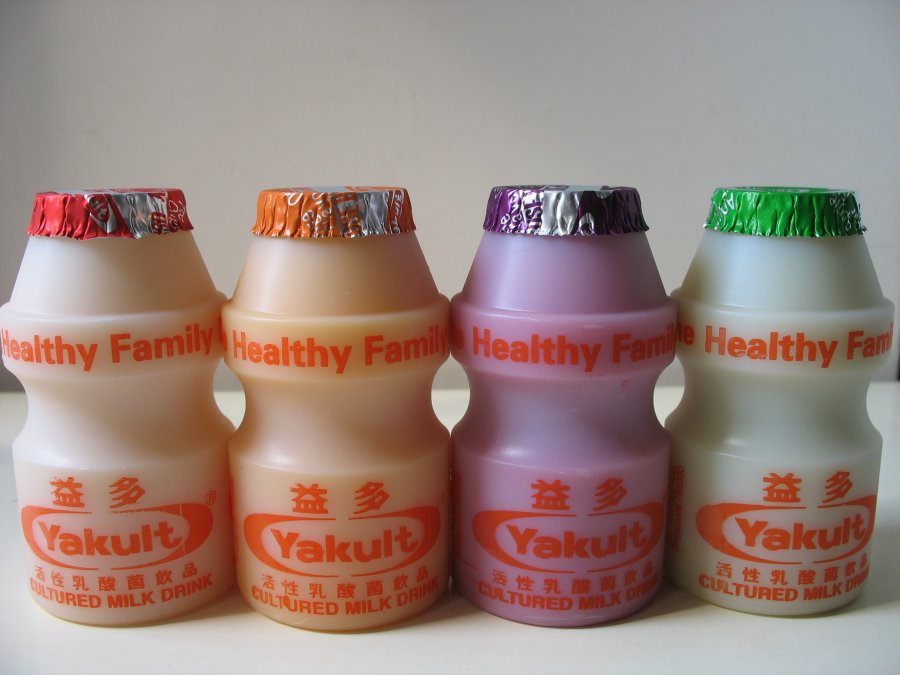 I know, I know, it's not a food, but it's so common that I felt it deserved to be included. Liquid yogurt says it all. Yakult is actually a popular brand for the drink which is called yakuruto, and is classified as a "fermented milk drink." And if you guessed this was a Japanese product, you guessed right. However, it's way more popular in Korea than it is in Japan; among both kids and adults. It's sold all over the world and comes in different flavors. But is like McDonald's where location determines what flavors are available. I know, I know, it's not a food, but it's so common that I felt it deserved to be included. Liquid yogurt says it all. Yakult is actually a popular brand for the drink which is called yakuruto, and is classified as a "fermented milk drink." And if you guessed this was a Japanese product, you guessed right. However, it's way more popular in Korea than it is in Japan; among both kids and adults. It's sold all over the world and comes in different flavors. But is like McDonald's where location determines what flavors are available.
|
|
Now, that you've got the scoop you can get to eating. Even if there aren't Korean restaurants around where you live, there a lot of sources for recipes and videos on how to make different items linked throughout the article. I wanted to try hoddeok so bad a couple of years ago, but nowhere here sold it as it's a true and true street food in Korea. So, I made it. It was fun to make despite not coming out the way it should have. It was the first food I bought in Korea, and I found out I had actually been pretty close to the real deal. So, don't be afraid to explore, but best of all, try something new. Feeling informed? Hungry? If you have any favorites on the list share them in the comments. If you've yet to try anything on the list, share which one(s) you'd be most interested in trying out. |
|
 Kdrama Tropes We Love to Hate
Kdrama Tropes We Love to Hate